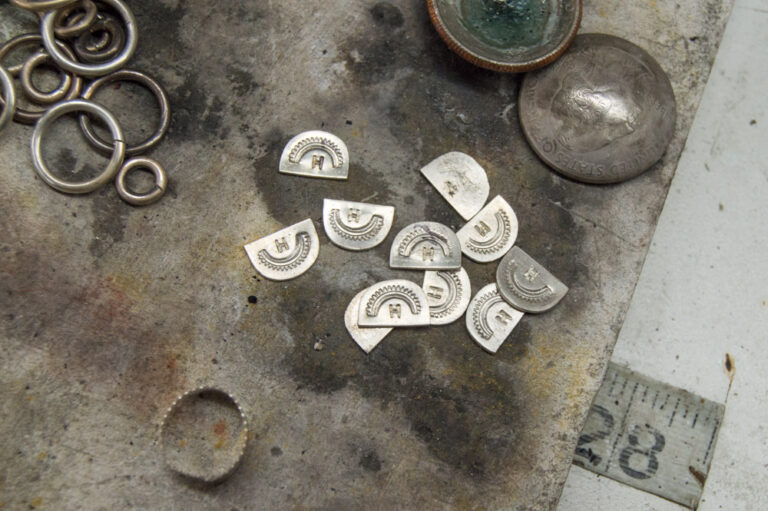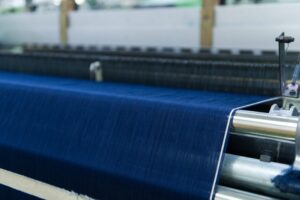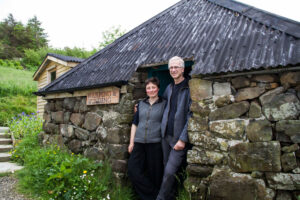
Obakki – A Purpose-Led Lifestyle Brand and Foundation
Founder Treana Peake, supports artisan partnerships and funds development work through the Obakki Foundation.
USA
Mood of Living October 23, 2015
Dennis Hogan, an American craftsman living in Santa Fe, N.M., began his career in the arts at only 16 years old. After attending the World’s Fair in Tennessee as a young teenager, Hogan became inspired by the heritage southwest design creations that surrounded him. Shortly after, he began crafting handmade roll-top boxes and rocking horses to sell at small local fairs. Since then, Hogan’s fascination and love of creating unique, beautiful items continued throughout his life. Finding everyday inspiration in the people, food, architecture and overall heritage southwest inspired art of Santa Fe as well as early Navajo jewelry of the 1860s through 1920s, Hogan’s vision has resulted in a timeless line of handcrafted jewelry “created for personal adornment over economic production.”
Hogan’s work remains historically influenced by place, design and, most importantly, technique. It’s all about the process in addition to the product. He can often be found in his workshop leaning over old pieces of railroad tracks and tree stumps with his favorite hammer in hand. Hogan uses his many repurposed tools to create a story of his own, while keeping in mind how they may have been used in the past.
By isolating elements of heritage southwest design and bringing them to focus, Hogan is able to take an element of history and reinterpret it, bringing the admirer to see a piece of history they had never seen before. Hogan’s simplistic style and use of archetypal figures, straight lines, shapes, spheres, and crescents offer an earthy element of simplicity to a complicated world, inspiring a true appreciation for handmade art.
Mood of Living: Before your current occupation you were…?
Dennis Hogan: I’ve held a number of traditional jobs en route to becoming a full-time artist. My first position was retail advertising in Indianapolis, Ind. However, I’ve always been an artist and craftsman, even as a child. While attending the World’s Fair in Tennessee with my parents, I became fascinated with a woodworker’s crafts on display – I must have been at least 16 or 17 years old. I returned home and started making roll top boxes and rocking horses and would sell my crafts at small fairs in my local area. I continued woodworking throughout college. This small business was my first introduction into creating arts and crafts on a production level. I learned the value and appreciation of quality materials – walnut, oak, cherry… I still use the knowledge gained from woodworking today. I graduated college from DePauw University with a BA in fine art specializing in landscape painting. My liberal arts education provided me with cultural exposure, a chance to travel to South America, and an opportunity to study fine art. A short time after graduating, I took a finished piece to a frame shop near my home, and the owner offered to carry my paintings in his fine art gallery. Editions Limited in Indianapolis gave me an opportunity to show my work. Several pieces sold during my first show, and I finally realized maybe I could make a career of the arts.
MoL: What attracted you to the Southwest?
D.H: My great grandmother’s brother, Uncle Clyde, was a homesteading cowboy in LaGrange, Wyoming. My family made the trip west when I was 10 years old and we visited Clyde at his ranch. He gave me his lariat and told me if I practiced, I could return to help him do ranching. I never made it back to Wyoming but have the lariat rope hanging in my office today. I became fascinated with the great American West.
Ghost Ranch in Abiquiú attracted me to New Mexico – the home of O’Keefe, a beautiful land. I began making annual visits to New Mexico and finally moved to Abiquiú in 1996 with hopes of becoming a painter.
MoL: How did you make the transition from painting to a full-time jeweler?
D.H: In 1997, I met a local artist and master leatherworker Charlie Favor at the hardware store in Abiquiú, NM. Charlie taught me the craft of fine leather braiding and for the next three years, I assisted him by hand braiding leather for his products. I began to develop an interest in jewelry and through my relationship with Charlie, I met other established artists, primarily jewelers.
In 2000, I moved to Santa Fe to begin marketing my own jewelry and leather work designs. Silversmithing became the perfect medium combining my experience of craft production with my love of fine art.
MoL: Where do you find your inspiration/motivation? What are some of your favorite art forms & artists, and how do they inspire your work?
D.H: I am motivated by my family. They are the reason I get up and work so hard. I want to take care of my daughters and offer them good opportunities. I am so happy they are growing up in a cultural city like Santa Fe; that is my motivation. I think motivation is more important than inspiration. It’s easy to get inspired when you live in a place like Santa Fe. Many artists are inspired, but are they motivated to work? My inspiration early on in my artistic career was George Innes, a late 19th-century American landscapist. His late works were painted with a soft-focus tonalism that conveyed the mood and feeling of a place. Studying Innes was the first time I ever understood emotion in art. I knew I wanted to create on an emotional level. As I mentioned, Santa Fe provides inspiration to me daily: the people, the food, the architecture, the culture. Of all the great southwestern arts, I’m most inspired by early Navajo jewelry 1860-1920s.
MoL: Do you have a favorite author, and how have they inspired the way that you approach your work?
D.H: I read historical western fiction by my author-friend Johnny D. Boggs. I also enjoy the clever writing of Mark Twain. But I’ve learned and applied the most from the writing and philosophies of John Wooden. I would say he has affected my life. Everyone will know him as the basketball coach for UCLA. When people say, “oh, the coach,” I comment, “the least of which he was a coach.” Wooden was a master at simple philosophies and motivating others to be their individual best. We were actually born in the same small town area in Indiana, so I suppose I can relate to his ideas. One of his great quotes is: “Make each day a masterpiece.” One of the lessons taught to him by his father: Don’t lie, don’t cheat, don’t steal. Don’t whine, don’t complain, don’t make excuses. Two sets of threes. How do you get any simpler? Wooden credits those basic rules to helping him achieve such a high level of success.
MoL: What is your favorite period of jewelry-making and how does it inspire your style?
D.H: Once again, early Navajo jewelry is my favorite. However, I enjoy most handcrafted jewelry created for personal adornment over economic production. I am inspired by jewelry for the sake of personal adornment and craft – handcraft – not production at the expense of quality. Timeless works. I hope my work can fall into that category at some point in my life.

MoL: How long have you been doing this and why have you continued?
D.H: It’s hard to say – it’s all an accumulation – silversmithing specifically since 2002. I started braiding in ’97, but I find it all an accumulation of what I am doing today. At age 50, I have been making arts and crafts in America for 34 years. I always wonder the difference between art and craft. I once heard it described as – Art is a form of work, which is an expression of emotion and feeling; whereas, craft is a form of work, which is an expression of experience and skills. A bricklayer could be a craft-maker. With my work today – since I have been a painter and a wood worker alike — I believe my jewelry really is a combination of both art and craft. It is important to me that a piece carries emotion and feeling, which I often achieve with patina. Yet, I need the technical skills to produce quality jewelry. A combination is what I hope I am today; An American craftsman, and an artisan. All my life experiences are in my art. It feels like I left Indiana and went through Egypt to get to New Mexico, but I needed to. If I had taken a shorter route, I wouldn’t be the same artist I am today.
MoL: Do you have a favorite quote?
D.H: Robert Frost: “Two roads diverged into a wood and I, I took the one less traveled, and that has made all the difference.”
MoL: Who is an influential figure in your life?
D.H: Not a particular person. My wife, my kids, my mom who supported my arts when I was young. I’m primarily a self-taught jeweler, but have had enormous help from everyone I have met throughout my journey; Craftsmen and women who were willing to teach, family for supporting me, patrons for being willing to buy my work, friends who were willing to loan me money — I’m so thankful. A mentor of mine, Charlie Favour, used to say: “All I can tell you is just always be making something, always be creating. No matter what your finances are, no matter where you are, or what’s going on in your life, always be creating something.”
MoL: What is your favorite part about the process of jewelry making?
D.H: My work is historically influenced by place, design and, most importantly, technique. I enjoy starting with simple, archetypal designs and letting the process begin. Most of my pieces develop at the workbench. As I’ve matured as an artist, I’ve learned when to quit and to not overwork a piece. To me, simplicity is best. I am all about the process over product; how I make something is far more important to me than what I make.
Those techniques would be:
Tufa casting – tufa is volcanic rock found extensively in the SW USA. It is perfect for carving molds and holding heat, used by early southwestern artists. This method of casting is the same technique used by artists when they first started melting silver coins to make jewelry.
Hammering ingot silver – Forging silver on my anvil is one of my favorite techniques. I am attracted to working in the old style because – if you change the process, you change the product. I want to leave evidence of my hands and hope the visual marks of my process are appreciated by others. I often visit the museums and admire the work created with so little tools and equipment. Many of my tools are repurposed – pieces of railroad track, stumps; I have a fascination with stumps. I use them for shaping and make tools out of scrap metal for stamping.
Stamps for decorating silver – Many are made commercially and not as fine as the older tools. I purchased many of my best stamps in pawn shops because, again, when they made those stamps, they weren’t making them to go sell at the jewelry supply. Early southwestern silversmiths viewed the time to make a tool as important as the time to make a piece of jewelry. I prefer used tools, especially hammers.
My favorite hammer came out of a Navajo silversmith’s toolbox from Gallup. When I am holding the hammer, I wonder what might have been created before me. It feels right. It feels worn. I hope to pass it on some day to the next generation of silversmiths. While the hammer doesn’t change my final product, the story behind the scene is very important to me. I keep my studio very creative with historical items all around – Navajo rugs, antique saddles, antique tools, etc.
MoL: What are some of the biggest challenges you have faced? What is the hardest part about this job?
D.H: The biggest challenge I have faced is surviving – just raw survival. I remember the days when I prayed to make $300 a week. One day, I remember walking up Canyon Road in Santa Fe trying to sell my jewelry. My daughter, Alyvia, was 3 months old at the time. With no money, $300 worth of jewelry and a picture of my daughter, I took off up Canyon Road, just trying to sell a bracelet or a pair of earrings. Store after store passed on buying and each time I would pull out the picture of my daughter. I’d begin to cry, wipe my eyes and go to the next door. Finally, a store called Nathalie’s bought $200 worth of jewelry. It felt like $20,000 worth. We took the money and bought a chocolate cake mix and icing. I’ll never forget those years and often wonder how we survived. I will tell you what the difference is – I kept going up that road. It was the raw necessity of staying alive until I could get to where I needed to be with my arts, and I didn’t want to let down my family. For the arts, as in life, you must have a purpose much bigger than your job. You need to have a reason to work, which is more important than the work you do.
MoL: What makes your jewelry so unique? Can you talk about how you have developed your individual style and technique over the years?
D.H: One thing I think makes my style unique is I am so historically influenced. There are people who copy historical designs, but I don’t feel I am that person; I enjoy studying historical designs and techniques and then showing my interpretation. My jewelry is unique because I isolate an element of historical design or technique and make it the focus. I am not reinventing anything. I like to take a piece of history and reinvent it – maybe show you a piece of history you haven’t seen before. For example, the blossom has mostly been presented as an accent on a necklace. I found a way to bring the classic design front-stage. I hope I can show people what they missed, or, maybe, what they didn’t appreciate quite as much at first.
You couldn’t tell me a better compliment than — “your jewelry is simple.”
I believe many people are searching for simplicity in a complicated world. Simple handcrafts became overlooked and, for the most part, replaced. We have been in the tech world for so long, I believe people are starting to, once again, appreciate something handmade.
MoL: What changes in the market today most affect your work?
D.H: People are starting to appreciate the simplicity of my work now more than ever. Sue Garland, one of my early mentors and patrons, once mentioned she learned to cook in Paris — “In Paris, they taught me to buy the freshest ingredients you could find, and do as little to them as possible.” I immediately made the comparison to jewelry. When silver gets expensive, don’t go thin. When TQ gets precious, continue to buy the best you can get. I can go sit just about anywhere and make something. I like that I don’t depend on a bunch of expensive tools, I rely on my ideas and process.
I’m fortunate to have found my way. When I think back on what has happened to me… it has been such a long journey. Finally, I am in the right place. I met the right people, I found the right influence, and I love it so much. I belong here.
MoL: What advice can you give anyone interested in being an artist?
D.H: Hard work is the easiest task you will face. Be kind to others, do something you love, stay humble, go discover who you are not. The sooner you learn that, the better.
Photography courtesy by Dennis Hogan for Peyote Bird Jewelry

Founder Treana Peake, supports artisan partnerships and funds development work through the Obakki Foundation.

Tatsushi Kuroki has made a career of infusing sustainability into the denim production process.

Andrea and Roger Holden traded in their agricultural lifestyle to set up a textile company in Scotland.